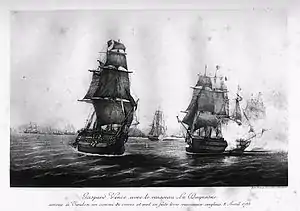 Gaspar Vence on Duquesne reaches Toulon with a convoy of food and drives three British ships away, 2 April 1794 | |
| History | |
|---|---|
| Name | Duquesne |
| Namesake | Abraham Duquesne |
| Laid down | January 1788 |
| Launched | 2 September 1788 |
| In service | 1789 |
| Captured | 24 July 1803 |
| Name | HMS Duquesne[1] |
| Acquired | Captured on 24 July 1803 |
| Fate | Broken up in 1805 |
| General characteristics [2] | |
| Class and type | Téméraire-class ship of the line |
| Tonnage | 1,901 bm[3] |
| Displacement | 2,966 tonnes |
| Length | 55.87 metres (183.3 ft) (172 pied) |
| Beam | 14.90 metres (48 ft 11 in) |
| Draught | 7.26 metres (23.8 ft) (22 pied) |
| Propulsion | Up to 2,485 m2 (26,750 sq ft) of sails |
| Armament |
|
| Armour | Timber |
Duquesne was a Téméraire class 74-gun ship of the line of the French Navy. She was captured by the British in 1803, and broken up in 1805.
French service
In 1793, under Captain Vence, she escorted an important convoy to the Levant, and then escaped a watching Anglo-Spanish squadron.[4]
In 1795, under Captain Allemand, she took part in the Battle of Cape Noli, and in the Battle of Hyères Islands.[4]
From mid-1801, she was armed en flûte and used as a troop ship. On 22 November 1802, she departed Toulon, bound to Saint-Domingue under Commodore Quérangal,[1] along with Guerrière and Duguay-Trouin.
The flotilla found itself caught in the Blockade of Saint-Domingue by the British ships Elephant, Bellerophon, Theseus, Vanguard, and Tartar. Guerrière and Duguay-Trouin managed to escape, and Duquesne, separated from the squadron, attempted to flee in the night. She was discovered by Tartar and Vanguard the next afternoon, and after a short artillery duel, Duquesne, outnumbered by her opponents, struck her colours.
Fate
Duquesne was incorporated in the Royal Navy as HMS Duquesne. In 1804, she ran aground on the Morant Cays. She was refloated in 1805, and sailed to England to be broken up.
See also
Citations
- 1 2 Benyon, P. (2011). "HMS Duquesne". Index of 19th Century Naval Vessels. Retrieved 3 April 2013.
- ↑ Clouet, Alain (2007). "La marine de Napoléon III : classe Téméraire – caractéristiques". dossiersmarine.free.fr (in French). Archived from the original on 23 March 2013. Retrieved 4 April 2013.
- ↑ Colledge, J. J.; Warlow, Ben (2006) [1969]. Ships of the Royal Navy: The Complete Record of all Fighting Ships of the Royal Navy (Rev. ed.). London: Chatham Publishing. ISBN 978-1-86176-281-8. P. 106.
- 1 2 "Les bâtiments ayant porté le nom de Duquesne". netmarine.net (in French). 2012. Retrieved 3 April 2013.
References
External links